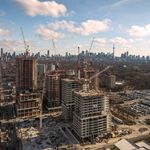I wonder if many are aware of the tremendous amount of smoke and soot damage that was suffered by downtown buildings during the 20th century. This 1949 photo clearly shows the blackened Royal York Hotel (centre-foreground) only 20 years after its construction. Similar results appears on the Bank of Commerce tower (at right) and the Toronto Star building (centre).
It's odd that the damage is always on the lower levels of those buildings…much less at the very top. I expect that may be explained by stronger winds at higher altitudes which would spread the soot further north.
The damaging soot, smoke and fumes would have come from surrounding factory chimneys, autmobile exhausts and the many locomotives in the rail yards south of Union Station.
View attachment 256975
Quite a different appearance during construction in 1928.
View attachment 256976




